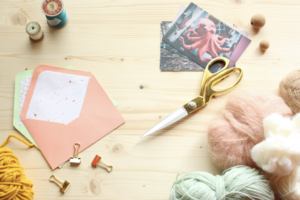Crafting has journeyed from a necessary survival skill to a celebrated form of personal and communal expression. This transition reflects changes in societal values, technological advancements, and cultural shifts.
The Historical Roots of Crafting
Crafting’s origins can be traced back to the dawn of civilization when it was essential for creating utilitarian items for daily use. Over time, these activities evolved into more sophisticated forms of expression and trade.
Ancient Crafting Techniques
In ancient times, crafting was not just a pastime but a crucial element of daily life. Techniques like weaving, pottery, metalwork, and woodworking were developed to create tools, clothing, and shelter, often imbued with cultural significance and artistic value.
The Industrial Revolution and Crafting
The Industrial Revolution marked a turning point, transforming crafting from a necessity to a hobby. As mass production took over, handmade crafts became valued for their uniqueness and the personal touch they represented.
Crafting in the 20th Century
The 20th century saw a resurgence in crafting, influenced by various social and economic factors. It became a way for individuals to express themselves, rebel against mass production, and foster community connections.
The Rise of DIY Culture
Post-World War II, the DIY (Do It Yourself) movement gained momentum, with people embracing crafting as a way to personalize their spaces and belongings, reflecting a desire for individuality and self-sufficiency.
Crafting as a Social Movement
In the latter part of the century, crafting emerged as a social movement. Movements like the feminist art movement in the 1970s used crafting as a form of political expression, challenging traditional gender roles and celebrating handmade crafts.
Modern Crafting Trends
Today, crafting has adapted to the digital age, becoming more accessible and diverse. The movement towards sustainability has also influenced contemporary crafting practices.
The Digital Age and Crafting
Technology has revolutionized crafting, with online platforms offering endless inspiration, tutorials, and communities. Social media has allowed crafters to share their creations, learn new techniques, and connect with a global audience.
Sustainable and Eco-friendly Crafting
There is a growing trend towards sustainable crafting, using recycled or eco-friendly materials. This shift reflects a broader societal move towards environmental consciousness and sustainability.
Crafting as a Form of Expression
Crafting is not only a hobby but also a powerful means of personal and artistic expression, offering mental health benefits and a sense of accomplishment.
Crafting and Mental Health
Engaging in crafting activities has been shown to reduce stress, improve mood, and enhance mental well-being. The repetitive nature of many crafts can be meditative, providing a respite from the digital overload of modern life.
Crafting in Contemporary Art
Crafting techniques are increasingly recognized and integrated into contemporary art, challenging the boundaries between fine art and crafts and highlighting the artistic value of handmade objects.
The Global Craft Community
The craft community extends globally, with festivals, events, and online platforms bringing enthusiasts together, fostering a sense of belonging and shared passion.
Crafting Festivals and Events
Crafting festivals and events offer opportunities for crafters to showcase their work, learn new skills, and connect with fellow enthusiasts. These gatherings celebrate the diversity and creativity of the crafting world.
Online Communities and Marketplaces
Online platforms like Etsy, Pinterest, and Instagram have revolutionized the craft market, enabling crafters to sell their work, share ideas, and build communities across geographical boundaries.
Conclusion: The Future of Crafting
The future of crafting looks vibrant, with ongoing innovations and a growing appreciation for handmade items. As crafting continues to evolve, it remains a testament to human creativity and the enduring desire to create and connect through the art of making.
FAQs:
How has the perception of crafting changed over time? Crafting has evolved from a necessity for producing utilitarian objects to a respected and cherished form of artistic and personal expression. Historically, it was a skill passed down for survival, but today, it’s celebrated as a means of creativity, self-expression, and mental well-being.
What role did the Industrial Revolution play in the evolution of crafting? The Industrial Revolution played a significant role in the evolution of crafting by shifting it from a necessity to a hobby. As mass production took over the creation of everyday items, crafting became a way to preserve individuality and personal craftsmanship, leading to the appreciation of handmade goods.
How has technology influenced modern crafting? Technology has significantly influenced modern crafting by providing access to a wealth of online resources, tutorials, and communities. Platforms like YouTube, Pinterest, and Etsy have made it easier for individuals to learn new crafts, share their work, and connect with a global community of crafters.
Why is sustainable crafting becoming more popular? Sustainable crafting is gaining popularity as people become more environmentally conscious and seek to reduce waste. Utilizing recycled, upcycled, or eco-friendly materials in crafting projects aligns with the broader societal trend towards sustainability and responsible consumption.
What impact does crafting have on mental health? Crafting has a positive impact on mental health by providing a therapeutic outlet that can reduce stress, anxiety, and depression. The process of creating with one’s hands can be meditative and fulfilling, offering a sense of achievement and a break from the fast-paced digital world, thus enhancing overall well-being.

